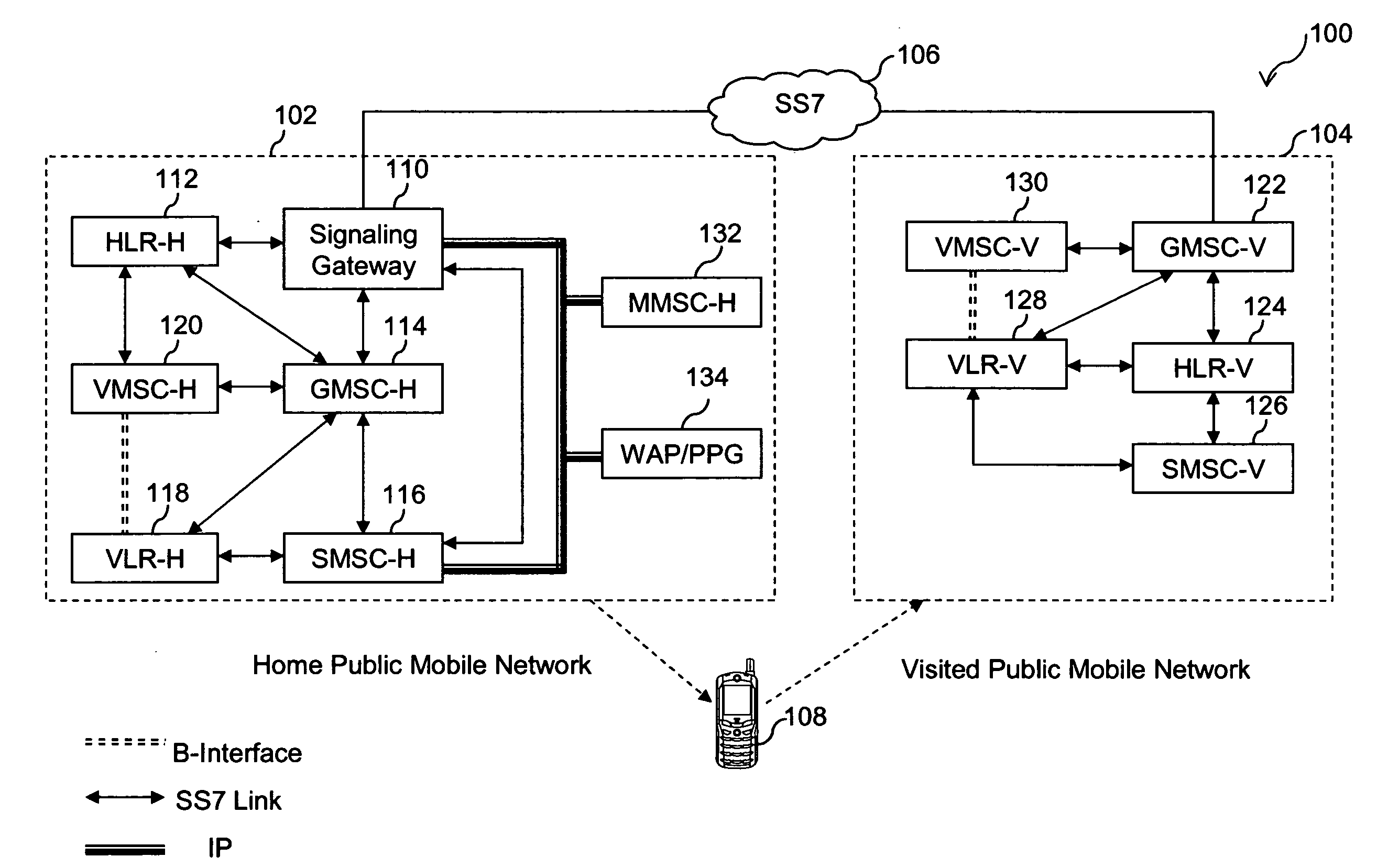Method and system for applying value added services on messages sent to a subscriber without affecting the subscriber's mobile communication
a value added service and subscriber technology, applied in the field of method and system for applying value added services on messages sent to a subscriber without affecting the mobile communication of the subscriber, can solve the problems of not being able to forward messages delivered from non-home smsc, message delivery in case of international roaming will still be a problem, and the smsc-based approach does not allow forwarding messages from non-home smsc to the hpmn subscriber
- Summary
- Abstract
- Description
- Claims
- Application Information
AI Technical Summary
Benefits of technology
Problems solved by technology
Method used
Image
Examples
first embodiment
[0053]Furthermore, in the present invention, SG 110 updates HLR-H 112 by sending a registration message to HLR-H 112 to replace VMSC-V 130 and VLR-V 128, with an address of SG 110. This enables SG 110 to receive all signaling VPMN 104 and HPMN 102 for subscriber 108. Also, the subscriber's profile is removed from VLR-V 128 due to fake registration message by SG 110. VLR-V 128 and VMSC-V 130 are associated with the subscriber's registered network. In an embodiment of the present invention, subscriber's registered network can be either the first, or the second network. Since, SG 110 updates HLR-H 112 to replace both VMSC-V 130 and VLR-V 128, with the address of SG 110, this approach is, hereinafter, referred to as non-split approach.
second embodiment
[0054]In the present invention, SG 110 updates HLR-H 112 by sending a registration message to HLR-H 112 to replace only VMSC-V 130 with the address of SG 110. In this embodiment, since VLR-V 128 is not affected, the subscriber's profile is still maintained at VLR-V 128. Therefore, this approach of replacing only VMSC-V 130 with the address of SG 110 is, hereinafter, referred to as split approach.
[0055]In an embodiment of the present invention, the address of SG 110 is modified to include a roaming identifier when subscriber 108 is present in VPMN 104. The roaming identifier may be a roaming GT assigned to SG 110 to signify that subscriber 108 is roaming. SG 110 thus updates HLR-H 112 by replacing VMSC-V 130 and VLR-V 128 with a modified SG 110, including the roaming identifier, in the non-split approach. However, in the split approach, SG 110 updates HLR-H 112 by replacing only VMSC-V 130 with the modified SG 110, including the roaming identifier. In another embodiment of the presen...
third embodiment
[0108]In third embodiment of the present invention, SG 110 has a built-in monitoring system in which, SG 110 periodically polls HLR-H 112 at configurable time intervals for any location update messages received at HLR-H 112. The time interval for polling may vary with the time of the day, like, every half an hour in night, while every 5-10 minutes during afternoon lunch time, when more subscribers are roaming and changing locations. While polling HLR-H 112, a case maybe detected where VMSC stored at HLR-H 112 does not match with the address of SG 110, which indicates that HLR-H 112 has been updated with subscriber's location information. Thus, SG 110 can again send location update message to HLR-H 112 to change the updated VMSC address to back the address of SG 110 as in explained in conjunction with FIGS. 4A and 4B.
[0109]After receiving the location update information at SG 110, SG 110 further sends a routing information query for MSISDN-A to HLR-H 112 using a message, such as Send...
PUM
 Login to View More
Login to View More Abstract
Description
Claims
Application Information
 Login to View More
Login to View More - R&D
- Intellectual Property
- Life Sciences
- Materials
- Tech Scout
- Unparalleled Data Quality
- Higher Quality Content
- 60% Fewer Hallucinations
Browse by: Latest US Patents, China's latest patents, Technical Efficacy Thesaurus, Application Domain, Technology Topic, Popular Technical Reports.
© 2025 PatSnap. All rights reserved.Legal|Privacy policy|Modern Slavery Act Transparency Statement|Sitemap|About US| Contact US: help@patsnap.com



